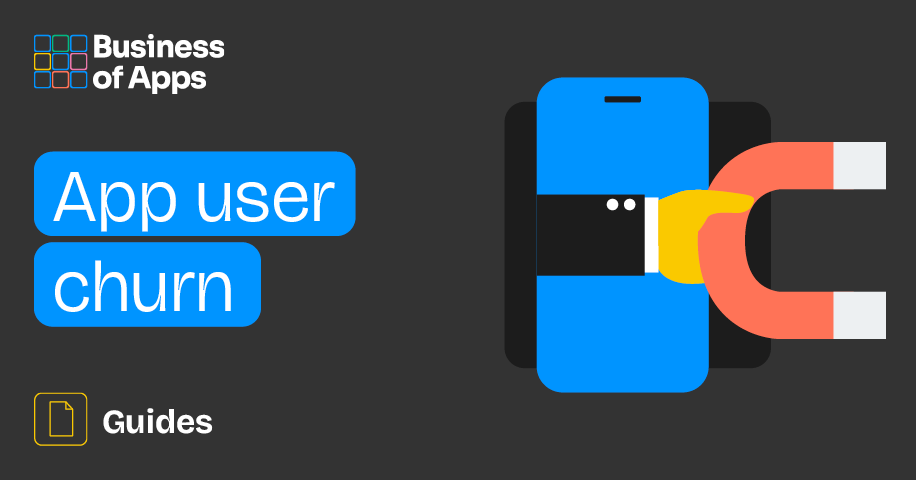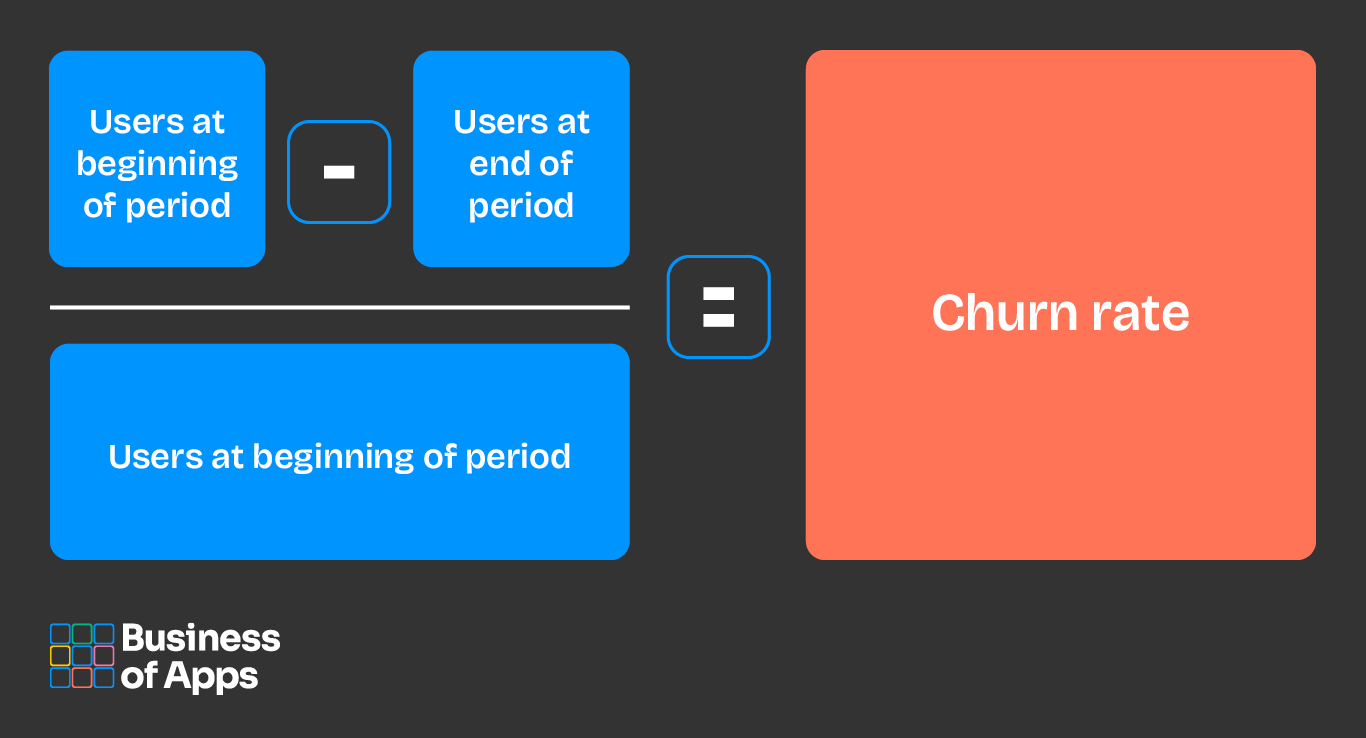User churn—the sworn enemy of all mobile marketers—refers to those users who abandon an app and never look back. With a sea of apps all competing for attention in an increasingly crowded market, churn stands as one of the most pressing challenges, threatening to derail growth and drain valuable resources if not effectively managed. Left unchecked, it can lead to dwindling user numbers, shrinking revenue, and ultimately, an app’s demise.
That’s why today, we’re diving deep into app user churn and everything you need to know about it. This guide will break down what churn is, why it matters, how to measure it effectively, and provide actionable tips to reduce and minimize it. If you want to thrive in today’s oversaturated marketplace, tackling churn head-on is simply a must.
What is user churn and where to find it?
At its core, app user churn is the percentage of users who hit the eject button and stop using your app over a specific period. It’s essentially the opposite of retention—if retention tells you how many users are sticking around, churn shows you how many are slipping through your fingers.
There are two main types of churn:
- Voluntary churn: This occurs when users either deliberately uninstall an app or stop engaging with it altogether, even if it’s still sitting on their phones. They’ve made a more or less conscious decision to leave you, essentially.
- Involuntary churn: This occurs due to things like technical glitches, expired debit/credit cards, or subscription lapses that users might not even realize are happening, or that they can’t easily fix on their own.
Understanding the root cause of churn is crucial to stopping it in its tracks. If you don’t know why users are leaving, you can’t take effective action to keep them around.
Common reasons why users churn:
- Lack of value or unmet expectations
- Poor user experience
- App too difficult to navigate
- Too many ads or intrusive notifications
- Technical issues or app crashes
- Complicated sign-up or onboarding process
- Features that don’t match their needs or interests
As we’ll dig into later, measuring churn and recognizing early warning signs are vital steps in minimizing user churn and turning the tide.
Download our App Engagement Buyer’s Guide, covering all the trends, strategies, and metrics you need to know to ace app engagement in 2025.App Engagement Buyer's Guide
App user churn key statistics
- Android has an average churn rate of 97.9%; iOS is faring slightly better at 96.3%.
- Most users churn on Day 1 after completing just a single session. By Day 30, over 95% of users on both Android and iOS have churned.
- Photo & Video apps have the highest average churn rate, while News apps have the lowest.
- At 98.5%, China leads the charts with the highest churn rate by country.
- Over 50% of annual subscribers are inactive by the end of their subscription.
- Lifestyle apps face the highest average subscription churn rate.
Source: Business of Apps
Check out our App Churn Rates (2024) report for more invaluable churn statistics.
Measuring user churn: How to catch it on time
To effectively tackle app user churn, the first step is tracking and analyzing it. Early detection is key—it lets you swoop in and take action before things spiral out of control. The sooner you spot the signs, the quicker you can put out the fire and keep users engaged. After all, a stitch in time saves a lot more than just a few frustrated users.
Basic churn rate formula
However, to get a more nuanced view of app churn, don’t just look at the overall numbers. Dive deeper by monitoring churn across different user segments—like new users, repeat users, or high spenders—because each group might churn for different reasons. Know the difference, and you can tackle the problem head-on with tailored solutions.
Cohort analysis is essentially your best friend here. By grouping users based on their in-app behavior or when they joined, you can track retention patterns more effectively. For instance, monitoring how users who signed up during a particular promo behave can offer key insights into how those offers impact churn.
Mobile marketers should also pay attention to early behavioral indicators—like a drop in session frequency, less time spent in-app, or fewer core actions being completed (think purchases or interacting with key features, it all depends on the type of app we are talking about). These subtle signs are often the canaries in the coal mine, warning you that a user is about to churn. Predictive analytics can help you spot these at-risk users early, giving you a golden opportunity to intervene before it’s too late.
And don’t forget about the power of feedback. Regularly monitor app store reviews and conduct in-app surveys to get direct insights into why users might be unhappy. Negative reviews about bugs, usability issues, or missing features are often red flags that user churn is lurking just around the corner. Keeping your ear to the ground on these helps you stay ahead of the game and fix problems before they snowball out of control.
Strategies and best practices to slash churn and keep users hooked
I think we all know by now that app user churn is no easy nut to crack. Beating it at its own game means learning to speak its language. So, let’s do just that. Below is our list of top tips and tricks to tackle user churn head-on, starting with the very first touchpoint a user has with an app—the onboarding experience.
Improve the onboarding journey
Onboarding is a user’s first interaction with an app, and we’ve all heard before that first impressions matter… they matter a lot.
Personalization, personalization, personalization
People in the app industry love speaking the language of personalization. It’s ubiquitous—and yes, I get it, it can sometimes get a bit annoying. That’s why it pains me to say this: yes, personalization is absolutely (putting it in italics for additional effect) crucial when it comes to reducing churn. But what does this actually mean, and what does it entail in practical terms?
Let’s start with something simple—messaging. Personalizing interactions, from emails and push notifications to in-app messages and content, is a powerful way to keep users engaged. It sends a very clear message (pun very much intended). It shows them you care and truly understand their needs and wants.
But that’s just the tip of the iceberg. There are countless ways to skin a cat, aka personalize an app experience. The key is to start by segmenting your audience based on factors like demographics, preferences, in-app behavior, and interaction history.
Utilize push notifications wisely
Push notifications are a double-edged sword. Sure, they can nudge users back into your app, but go overboard, and you might as well hand them a “delete app” button.
Don’t overdo it. Limit the number of notifications you send to each user. And here’s the kicker—segmentation is your best friend. Group your users into cohorts and send each group notifications that truly resonate with them. To repeat myself, that’s how you win the churn game.
Offer time-sensitive rewards
Rewards—especially the time-sensitive, personalized kind—are a surefire way to keep users hooked. Think discounts, special offers, or in-app credits. They don’t just boost retention; they create a sense of urgency and excitement that keeps users coming back for more.
For freemium apps, this strategy is pure gold. Offering rewards for continued usage or achieving milestones not only curbs app user churn but also builds loyalty and strengthens the emotional connection users feel toward an app.
Collect and act on feedback
Regularly collecting feedback through in-app surveys or user interviews is a must for understanding what’s clicking and what’s falling flat. Apps that take the time to listen and actively address user complaints—whether it’s squashing bugs, tweaking features, or rolling out new ones—have a serious edge. Put simply, apps that prioritize user input see significantly lower churn rates.
Here’s the kicker: it’s not just about fixing issues; it’s about making users feel heard. When users know their opinions matter and see real changes based on their feedback, they’re more likely to stick around and stay loyal.
Improve app performance
Few things frustrate users more than slow-loading screens, glitches, or outright crashes. These aren’t just minor annoyances—they’re deal-breakers. Regularly audit your app’s performance to remove bugs, speed up load times, and ensure buttery-smooth interactions. Why? Because poor performance is a one-way ticket to uninstalls.
In other words, prioritize bug fixes and act fast, especially on user-reported issues. Not only does this improve satisfaction, but it also sends a loud and clear message: you care about their experience. And don’t just stop at bug fixes—proactively test for weak spots, optimize features, and stay ahead of performance hiccups. Remember, a seamless app experience isn’t just nice—it’s the baseline expectation if you want users to stick around.
Re-engagement campaigns
If a user hasn’t engaged with the app in a while, it’s time to kick off a re-engagement campaign. This could be anything from special offers and reminders about unfinished actions (think those abandoned shopping carts) to reaching out with fresh content they might have missed.
The key is to offer something tangible and meaningful to each user, making the campaign irresistible enough to pull them back in. For maximum impact, throw in a personalized touch that speaks directly to their interests and past behavior. You want them to feel like they’re getting something just for them, something special no one else is getting, something they can’t resist.
Finally, consider using retargeting campaigns to reach users across different channels—like social media, email, display ads, etc. Retargeting helps you stay top of mind and reminds users of what they’re missing, all while reinforcing the personalized experience. It’s a great way to nudge users back without bombarding them with unnecessary information and irrelevant offers, making sure they feel valued and not just overwhelmed.
Predictive user churn analysis
Predictive modeling is your secret weapon for spotting users who are on the verge of churning based on their behavior and usage patterns. It’s like having a crystal ball that reveals who’s about to slip away. By identifying these users early and leveraging the strategies discussed above, you can get ahead of the game and stop churn before it even happens.
Once you know exactly which users are at risk of churning, you can swoop in and reach out to them with tailored offers, exclusive content, or a friendly nudge that makes them feel special. It’s all about showing you’re paying attention and that you really get what they want and need. It’s way more effective than waiting for the inevitable “goodbye” message and scrambling for a last-ditch effort. Instead, stay a step ahead, and turn potential churn into continued loyalty.
Segment and prioritize users
Not all users are created equal. Some, like heavy spenders or long-time loyalists, are far more valuable to keep around. Segment your users into cohorts based on factors like activity level, spending habits, or engagement frequency, then tailor your retention strategies to fit.
High-value users may need personalized offers or even one-on-one outreach, while more casual users might respond better to push notifications or fresh content updates. The key is treating each group in a way that feels right for them—keeping them engaged and invested.
Final thoughts
Let’s face it, there’s no way to completely remove app user churn from the equation. It is an inevitable part of running a mobile app, but it doesn’t have to be an overwhelming problem that keeps mobile marketers and developers alike awake at night, cold sweat running down their foreheads. What’s more, it doesn’t take much to control user churn and keep it in a state of permanent check (even if you can never really mate it).
By understanding what app user churn is, how it works and why it happens, measuring it effectively, and implementing proactive retention strategies, app marketers can keep users engaged and massively reduce an app’s churn rate. Suddenly, the nightmare of watching an app’s user count steadily decline day by day is no longer. The terror has been vanquished, and the days of desperately trying to stop the bleeding are now firmly in the past.
Of course, things are always easier said than done. However, the rewards of uncovering the causes of app churn and crafting effective strategies to combat and counteract it far outweigh the blood, toil, tears, and sweat invested in the process. Besides, solving app user churn (if you would forgive me the grandiosity) doesn’t just improve an app’s retention metrics, it’s also a stellar way to shore up an app’s acquisition costs, ensuring your UA budget doesn’t go to waste. If you’re going to spend serious money to bring in users, you’d better make sure they don’t vanish on day one, disappearing as quickly as they arrived.
Improving onboarding, personalizing engagement, offering tangible and meaningful rewards, and keeping an app running smoothly are all essential practices that will help minimize user loss. However, this is hardly an exhaustive list. Every app is unique, and there are countless reasons why user churn occurs. What works for one app won’t necessarily work for another.






